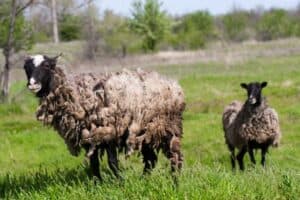Sheep shearing is essential because it keeps your sheep comfortable in the summer. It is also a hygiene practice that rids the animal’s body of disease-causing pathogens and parasites. If sheep stay for long without shearing, they may develop wet patches that are unsightly and smelly. So what is a wet patch in sheep shearing, and how does it affect sheep? Is the wet patch a normal occurrence?
A wet patch is a damp, green-like, and foul-smelling patch on a sheep’s wool that occurs when flies infest a sheep and lay eggs that hatch into larvae. These maggots feed on the sheep’s skin and may lead to painful wounds and infections. In severe cases, the affected sheep suffer ammonia toxicity, get into a coma, and eventually die.
Shearing sheep regularly can protect them from flystrike because short wool covering is hygienic, manageable, and cannot hide maggots underneath.
If you’ve heard someone say their sheep have wet patches and wondered what they meant, this article will discuss what a wet patch in sheep shearing means in detail.

What Is a Wet Patch in Sheep Shearing?
As the name suggests, a wet patch is a dump patch that occurs when flies infest a sheep, settle on the wool, and lay eggs. The eggs hatch into larvae that start eating the sheep’s skin as they excrete waste on the same patch.
The mixture of burrowing maggots eating into the skin and excreta makes the patch damp, green-like, and smelly.
When this condition affects several sheep or all your flock, you have flystrike infestation. In such a scenario, shearing your sheep may be challenging.
Even before a shearer points out that your sheep have wet patches, you may notice specific behavioral changes that point to a flystrike.
First, the sheep are agitated and restless, especially when resting. They stamp their feet, rub against a wall or fence, and try to kick the affected area with their hind legs.
You may also notice the sheep biting or wagging their tails or an abrupt head movement due to discomfort. Additionally, fly-struck sheep look dull, exhausted, and with no interest in grazing.
Sheep shearing is one of the best ways to treat and manage wet patches in sheep. The wet patches may be slippery and challenging to shear, so the shearer should be careful to avoid hurting themselves or the sheep.
When the sheep are shorn, apply an appropriate chemical to treat the area, such as an aqueous solution of Ivermectin and Crovect.
READ ALSO: How To Shear A Sheep With Hand Shears? (Practical Guide!)
Is a Wet Patch Normal in Sheep?
Wet patches are normal and quite common in sheep, with atleast 75% of sheep experiencing flystrike in a year. Sheep are more susceptible to flystrike during the rainy season when the chances of having damp wool are high.
Sheep’s wool will absorb moisture from the rainfall, and when the hot weather persists, the flies will settle on the wool, especially if it has urine and fecal matter.
A mixture of dampness, warmth, urine, and fecal matter is the perfect ground for these flies to lay eggs, which hatch into larvae.
How To Prevent Wet Patches in Sheep
There are various ways to prevent or reduce the occurrence of wet patches in sheep. They include;
Shearing and Crutching
Long wool harbors moisture and takes a long time to dry, predisposing sheep to fly infestation and the development of wet patches.
To prevent flystrike in your flock, keep your sheep’s wool short all the time. However, if a flystrike happens, you can manage it by shearing the sheep.
Additionally, you can crutch the affected area, remove the larvae and apply the chemical treatment.

Tail Docking
While wet patches can occur anywhere in a sheep’s body, they are common in the buttocks and tail area, where urine and fecal matter are trapped over time.
Tail docking removes lamb tails at weaning and reduces the accumulation of dirt and poop in the tail region.
Applying Preventative Medicines
As mentioned earlier, wet patches are common in particular periods, such as during rainy summers. You can apply preventative meds such as ivermectin, dicyclanil, and cyromazine to sheep’s wool to keep off flies.
These meds are best applied before a flystrike season or during high-risk periods such as rainy and warm days.
Selective Breeding
Some sheep are more susceptible to flystrike due to their genetic predispositions. These traits include wrinkles, dag, and breech cover.
You can selectively breed sheep with fewer wrinkles, less dag, and an uncovered breech because they will be more resistant to flystrike.
Keeping Herding and Sleeping areas Hygienic
Urine and fecal matter are critical factors in attracting flies that infest sheep. Keeping herding and sleeping areas clear of manure heaps and urine will prevent flystrike.
READ ALSO: How Do Wild Sheep Survive in The Wild Without Shearing?
Final Thoughts
A wet patch is a damp, foul-smelling patch on a sheep’s wool caused by a fly infestation. The flies lay eggs on the surface of sheep skin, which hatches into larvae that start feeding on the skin, causing wounds and fatality in severe cases.
Wet patches can affect your flock, but there are effective methods to prevent them, such as shearing sheep and applying preventative chemicals.
RECENT ARTICLES
Why Do Sheep Follow Each Other? (5 Things To Know!)
Why Do Shepherds Put Oil On Sheep?
Why Do Sheep Have Paint on Them? Interesting Facts
Sheep Lying Down A Lot? (Cause for Worry?)




